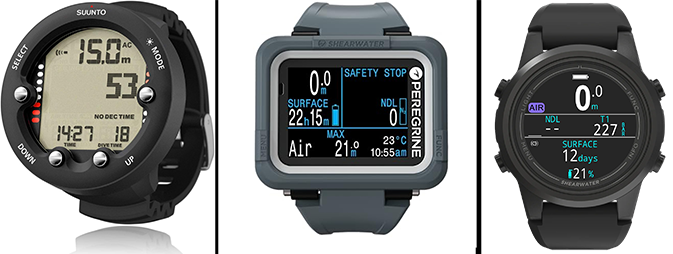PDCs ADD TO DIVE SAFETY… BUT PLEASE DO YOUR HOMEWORK
Recently, there have been a few social media posts that send mixed messages about the roles and benefits of personal dive computers to recreational divers. It could be that the winter layoff in the northern hemisphere has ‘rusted’ familiarity with PDCs for some divers, and they have forgotten the basics, but we figured a quick recap might do some good.
Let’s start by saying that RAID is a strong advocate for PDCs. We require students to understand and use them from OW20 on. (Although standards do allow basic divers to substitute depth gauges/bottom timers and traditional dive tables, PDCs are recommended even at beginner levels nevertheless.)
Secondly, regardless of how many dives you have, how long you’ve been diving, or which PDC you use, if it and you have been dry for a month or two, a good plan is to reread the owner’s manual! Especially the section on setting conservative levels, and how that translates to your well-being! You might be reminded of something important.

All that aside, most of us feel a whole lot more comfortable, and protected with a PDC helping on our dives. And here’s why
- Real-time Dive Information: All late generation PDCs display crucial data like current depth, bottom time, ascent rate, and remaining bottom time, helping you stay within safe limits and avoid major issues.
- Safety: Dive computers continuously monitor and calculate your dive profile, providing safety features like audible alarms for ascent rate, depth, and decompression limits.
- Customization: And this is a big plus because you can customize settings based on your personal factors like age, physical condition, and diving experience, allowing for a more accurate dive profile. Generally speaking, conservative is better.
- Logbook: Dive computers typically keep a log of your dives, enabling you to track your progress, monitor dive trends, and plan future dives more effectively. They also help to keep your online RAID profile up-to-date.
- Versatility: Many late gen. models offer additional features like air integration, compasses, digital interfaces for data transfer, and advanced dive planning tools.
However, that said, in spite of the many benefits PDCs provide, and the safety advantages of having real-time information about one’s dive, and instant feedback on decompression status, they’re not a panacea. Wearing a PDC cannot guarantee immunity to DCS; nothing can. Decompression sickness is one of the risks we can manage but never iraticate.
One another note: PDC are not immune to suddenly going pear-shaped… especially if battery warnings are ignored!
If your computer screen goes black part way through a dive, try to relax. As long as you’ve been diving within recreational limits, a dodgy PDC is an inconvenience rather than a dive emergency. Step one, your dive is over, no questions. Step two, check your cylinder pressure because having plenty to breathe is critical. Once that’s done, and you know you have plenty of gas, you’re golden.
Signal your buddy, let them know you have an equipment issue, and then make a controlled ascent to the safety stop. Execute it (an extended stop would be best as long as you have sufficient gas), surface normally, establish buoyancy and explain the issue to your buddy. You might apologize and offer to buy the dessert at supper or something comparable. And as for fixing the issue, chances are that the problem is a dead battery… and that’s a simple fix. However, to be extra safe, it does mean you are out of the water for 24 hours.
Hope this clears things up for anyone who’s getting back in the water after a long dry spell.
#theraidway™


